Section 8 Housing: 5 Reasons to Use this Dynamic Investment Strategy
 By K ‘Dia Brooks, author of Fundamentals of Financing: How to leverage ethics, economics, and personal accountability to achieve multi-family success
By K ‘Dia Brooks, author of Fundamentals of Financing: How to leverage ethics, economics, and personal accountability to achieve multi-family success
Real estate investing is one of the easiest ways to acquire generational wealth, passive income, and long-term economic stability. When we got started in real estate, we soon realized that we were truly one deal away from changing our family’s life.
Starting out wholesaling houses truly gave me that foundation and entry level admittance into the world of real estate. It taught me how to connect with clients/buyers, fundraise, and establish myself in my region. However, I realized that I was doing such a great deal of work, for the small gains of a wholesale fee and started digging my heels down into everything that is offered in the real estate industry. Specifically, in multi-family real estate.
There were extreme hurdles when it came to financing single family homes or residences under 4 units, and I immediately looked towards the viability of financing my first multifamily property. Multi-family investing has the benefits of providing residual income to you as the property owner, allows you to scale and expand your portfolio, and (believe it or not) it’s easier to finance.
One of the best financing structures to use, especially as a novice investor, is Section 8 Housing. Section 8 housing is often associated with poor and unruly tenants, slum housing, and poor monthly cash-flow, and that is far from the truth. The HUD 223 (f) program is the gem each investor should know about because this program, in combination with other HUD programs, gives new investors the ability to 100% finance their multi-family properties.
Here are 5 reasons you should invest in Section 8 Housing:
1. 100% Financing
Affordable housing projects qualify for 87-90% Loan-to-value (LTV) simply for servicing lower-income section 8 tenants, however in conjunction with grants and other equity sources, funding easily exceeds 100% financing. This is an incredible benefit for new investors, however it’s very important to do your due diligence so that you can ensure that you are adequately cash flowing to cover the debt service and your monthly profit.
2. Non-Recourse Loan
Non-Recourse Loans are a great benefit to new investors since we are often entering the industry with very little capital and assuming the innate risks that come along with investing in real estate. Non-recourse debt is a type of loan secured by collateral, which is usually property. If the borrower defaults, the issuer can seize the collateral but cannot seek out the borrower for any further compensation, even if the collateral does not cover the full value of the defaulted amount.
3. Eligible for RAD Conversions
Rental Assistance Demonstration (RAD) is a voluntary program that allows public housing authorities (PHAs) and owners of other HUD-assisted properties to convert units from formula-driven operating and capital funding to long-term (minimum 15 years), project-based Section 8 contracts. The primary benefit of RAD is that properties that convert under this process are no longer restricted from securing private sources of financing, and the owners are therefore able to address deferred maintenance issues that have caused Public Housing and other HUD rental stock to deteriorate nationwide.
4. Combine with LIHTC
LIHTC is the federal government’s primary program for encouraging the investment of private equity in the development of affordable rental housing. Since its creation in 1986, LIHTC has helped finance more than 2.4 million affordable rental-housing units for low-income households. LIHTC (pronounced lie-tech) is an indirect federal subsidy. To promote affordable multifamily housing, the IRS allocates tax credits each year to state Housing Finance Authorities, and developers subsequently apply for an allocation of these credits for their project. For developers that do not have experience with this process, Bedford Lending will help. Investors are eager to purchase tax credits, as they provide a substantial return on investment.
HUD financing can be combined with LIHTC to:
- Cover 100% of cash required at closing, provide a Developer’s Fee, and pay for HUD escrows required during construction, if applicable. (i.e., for operating deficits and construction contingencies).
- Qualify for streamlined HUD processing, which typically reduces processing time by up to 2 months.
- Removes limits on secondary financing
5. 35-Year Fixed Rate
By extending the time that investors must pay back the loan, they are granted with lower monthly mortgage rates, which are essential perks to a section 8 investor. By investing in section 8 housing, you receive rent from tenants and the government that is far less than market rate. So, a lower monthly mortgage allows you to ensure that you make enough monthly income to cover your debt service.
Section 8 housing is slowly losing its negative connotation and everyday investors are finding the benefits of utilizing this financing structure and growing their real estate portfolio with very little up-front capital.
In my book, Fundamentals of Financing, I dive into the intricacies of using this financing structure to scale your multi-family portfolio, as well as how to combine these with private equity funds to enhance your financing capital stack. This book will not only teach you how to 100% finance your first multi-family property but show you how economics and ethics are key components of sustainability in this industry.
Remember, you’re just ONE deal away from changing your life.
About the Author:
















 Accessibility
Accessibility